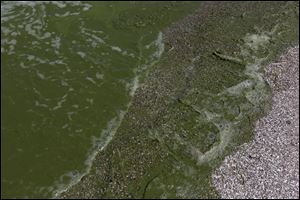
LUCAS COUNTY
Commissioners OK resolutions aimed at avoiding water woes
8/8/2014
The Lucas County Commissioners passed three resolutions aimed at bettering Lake Erie.
The Lucas County commissioners on Thursday took up the environmental health of Lake Erie and its impact on the drinking, cooking, and bathing water of nearly a half million people with the approval of three resolutions.
“This weekend was a call to action for all of us,” Carol Contrada, president of the commissioners, said, referring to the algae bloom that led to a two-day ban on using water that entered the city of Toledo’s intake system in the lake.
Mrs. Contrada and commissioners Tina Skeldon Wozniak and Pete Gerken shared information on the resolutions before the special commissioner’s meeting in a meeting with The Blade’s editorial board.
One resolution supports the implementation of recommendations in the International Joint Commission’s report released in February on algal blooms in the western basin of Lake Erie and called on state legislators in the Maumee River watershed to introduce a law to adopt the recommendations.
The report by the independent binational organization created by Canada and the United States under the Boundary Waters Treaty of 1909 said the biggest source of phosphorus entering Lake Erie came from the Maumee River, the largest watershed in the Great Lakes, and called for voluntary controls. It urged changes in what enters lake tributaries, targeting sewage treatment plants, open-lake dumping of dredge materials, faulty septic systems, and urban lawn fertilizers. It also calls for more wetlands buffer zones.
Among its recommendations were having farmers avoid fertilizing fields in autumn and reducing fertilizer applied from March 1 through June 30 and a ban on applying manure, biosolids, and commercial fertilizers containing phosphorus on frozen ground and ground covered by snow if the land drains into Lake Erie.
The commissioners also approved spending up to $100,000 to implement the source water action plan that was included in the Toledo-Lucas County Sustainability Plan. The action plan will help identify pollutants and contaminants that enter the lake and how to mitigate them.
“We believe the study is timely. It was to occur this summer. There is no time like the present with what we experienced this past weekend.” Mrs. Wozniak said.
The third resolution acted on by the commissioners attempts to revive an effort that began in the late 1990s on a study for a multijurisdictional water authority to distribute water throughout the region.
Mr. Gerken said the county is committed to spending $175,000 of the $350,000 needed to form the Toledo-Lucas County water district, but an equal amount is required from the city of Toledo.
“The time is now to act and complete that study,” he said.
“We believe the creation of a Toledo-Lucas County water district authority is needed now more than ever.”
All three resolutions received unanimous approval by the board.
Today, four state representatives will hold a news conference in Oregon to discuss the Toledo water crisis and the algae blooms. Hosted by Reps. Michael Sheehy (D., Oregon), Michael Ashford (D., Toledo), Chris Redfern (D., Catawba Island) and Teresa Fedor (D., Toledo), it is to be at 10:30 a.m. in Lake Erie Center, 6200 Bay Shore Rd.
In a related matter, the Lake Erie Legislative Caucus announced a public meeting at 10 a.m. Aug. 15 at Maumee Bay State Park to discuss algae and the water crisis. Hosts are state Sen. Randy Gardner (R., Bowling Green) and Mr. Redfern.
“We believe the discussion and work toward solving the algae crisis facing Lake Erie must be elevated to a new level,” Mr. Gardner said in a statement.
Contact Mark Reiter at: markreiter@theblade.com or 419-724-6199.